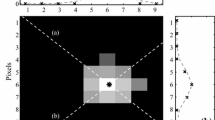Abstract
Digital particle-tracking velocimetry is used to obtain the two-dimensional structure of the head of inertial gravity currents propagating along a no-slip boundary. The early stage of development of lock-release gravity current experiments is recorded in the laboratory frame of reference and subsequently transformed by software to a frame moving with the current head. Time averages of these statistically stationary flows are computed, with the technique providing not only the mean two-dimensional velocity field but also the vorticity, shear stress and divergence fields, and streamlines of the flows. The distributions of the magnitude of the fluid velocity fluctuation and Reynolds stress complete the picture of the flow. Key features of the flow are broadly in line with earlier qualitative and quantitative investigations, and the detailed measurements presented here confirm some of the most recent findings from numerical simulations.






Similar content being viewed by others
References
Alahyari A, Longmire EK (1996) Development and structure of a gravity current head. Exp Fluids 20:410–416
Batchelor GK (1974) An introduction to fluid dynamics. Cambridge University Press, Cambridge
Benjamin TB (1968) Gravity currents and related phenomena. J Fluid Mech 31:209–248
Britter RE, Linden PF (1980) The motion of the front of a gravity current travelling down an incline. J Fluid Mech 99:531–543
Britter RE, Simpson JE (1978) Experiments on the dynamics of a gravity current head. J Fluid Mech 88:223–240
Dalziel SB (1992) Decay of rotating turbulence: some particle tracking experiments. Appl Sci Res 49:217–244
Dalziel SB (1993) Rayleigh–Taylor instability: experiments with image analysis. Dyn Atmos Oceans 20:127–153
Dalziel SB (1995) DigImage: system overview. Cambridge Environmental Research Consultants, Cambridge, UK
Hartel C, Kleiser L, Michaud M, Stein CF (1997) A direct numerical simulation approach to the study of intrusion fronts. J Eng Math 32:103–120
Hartel C, Meiburg E, Necker F (2000) Analysis and direct numerical simulation of the flow at a gravity-current head. 1. Flow topology and front speed for slip and no- slip boundary. J Fluid Mech 418:189–212
Huppert HE, Simpson JE (1980) The slumping of gravity currents. J Fluid Mech 99:785–799
Kneller BC, Bennet SJ, McCaffrey WD (1999) Velocity structure, turbulence and fluid stresses in experimental gravity currents. J Geophys Res 104(C3):5381–5391
Parsons JD, Garcia MH (1998) Similarity of gravity current fronts. Phys Fluids 10:3209–3213
Rottman JW, Simpson JE (1983) Gravity currents produced by instantaneous releases of a heavy fluid in a rectangular channel. J Fluid Mech 135:95–110
Simpson JE (1972) Effects of the lower boundary on the head of a gravity current. J Fluid Mech 53:759–768
Simpson JE (1997) Gravity currents: in the environment and the laboratory, 2nd edn. Cambridge University Press, Cambridge
Simpson JE, Britter RE (1979) The dynamics of the head of a gravity current advancing over a horizontal surface. J Fluid Mech 94:477–495
Acknowledgements
Experiments were performed in the Laboratory of Fluid Dynamics, Department of Applied Mathematics and Theoretical Physics (DAMTP), University of Cambridge, UK. LPT thanks Universidad Nacional del Centro de la Provincia de Buenos Aires and Consejo Nacional de Investigaciones Científicas y Técnicas de la República Argentina for grants to support his visit to DAMTP. SBD acknowledges the support of Yorkshire Water plc.
Author information
Authors and Affiliations
Corresponding author
Rights and permissions
About this article
Cite this article
Thomas, L.P., Dalziel, S.B. & Marino, B.M. The structure of the head of an inertial gravity current determined by particle-tracking velocimetry. Exp Fluids 34, 708–716 (2003). https://doi.org/10.1007/s00348-003-0611-3
Received:
Accepted:
Published:
Issue Date:
DOI: https://doi.org/10.1007/s00348-003-0611-3




